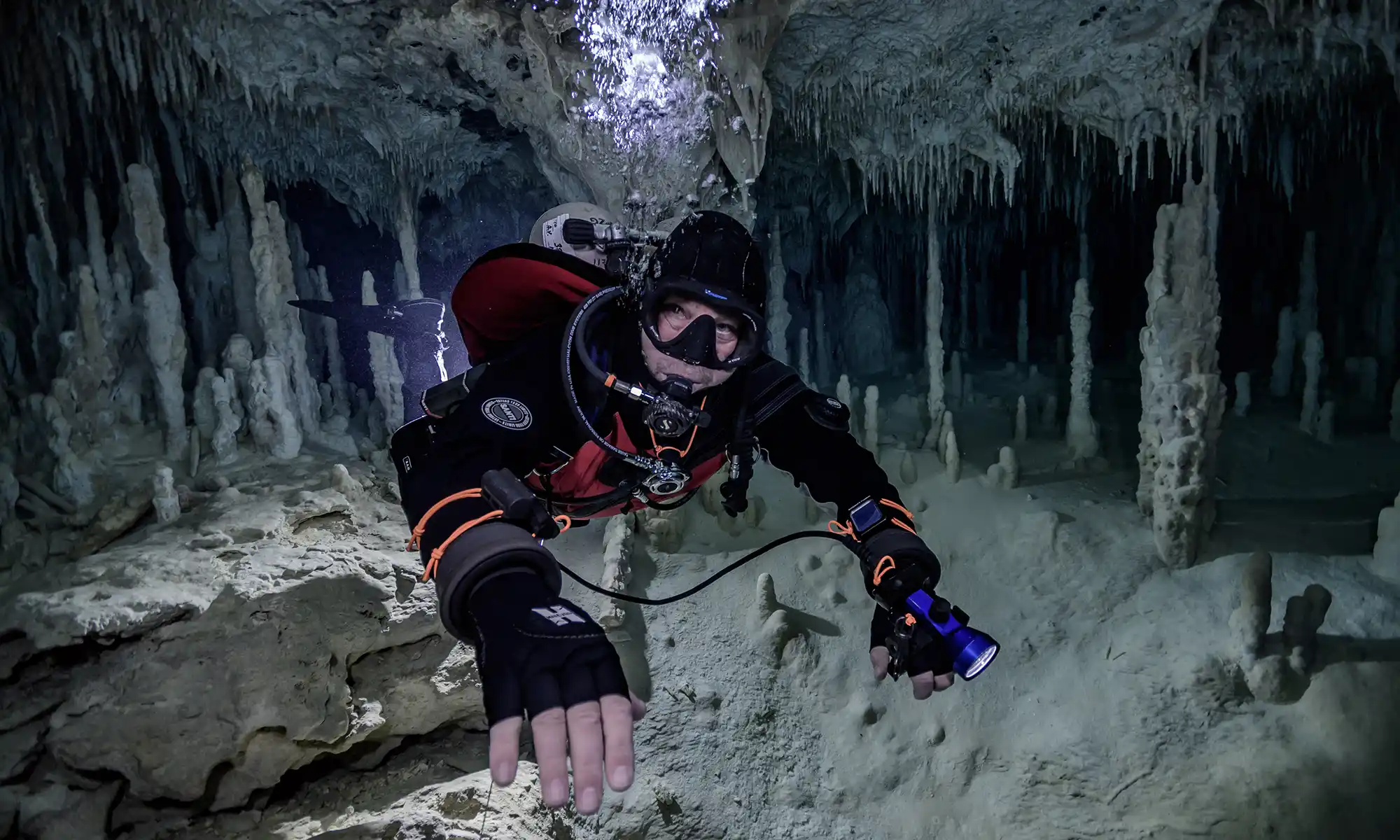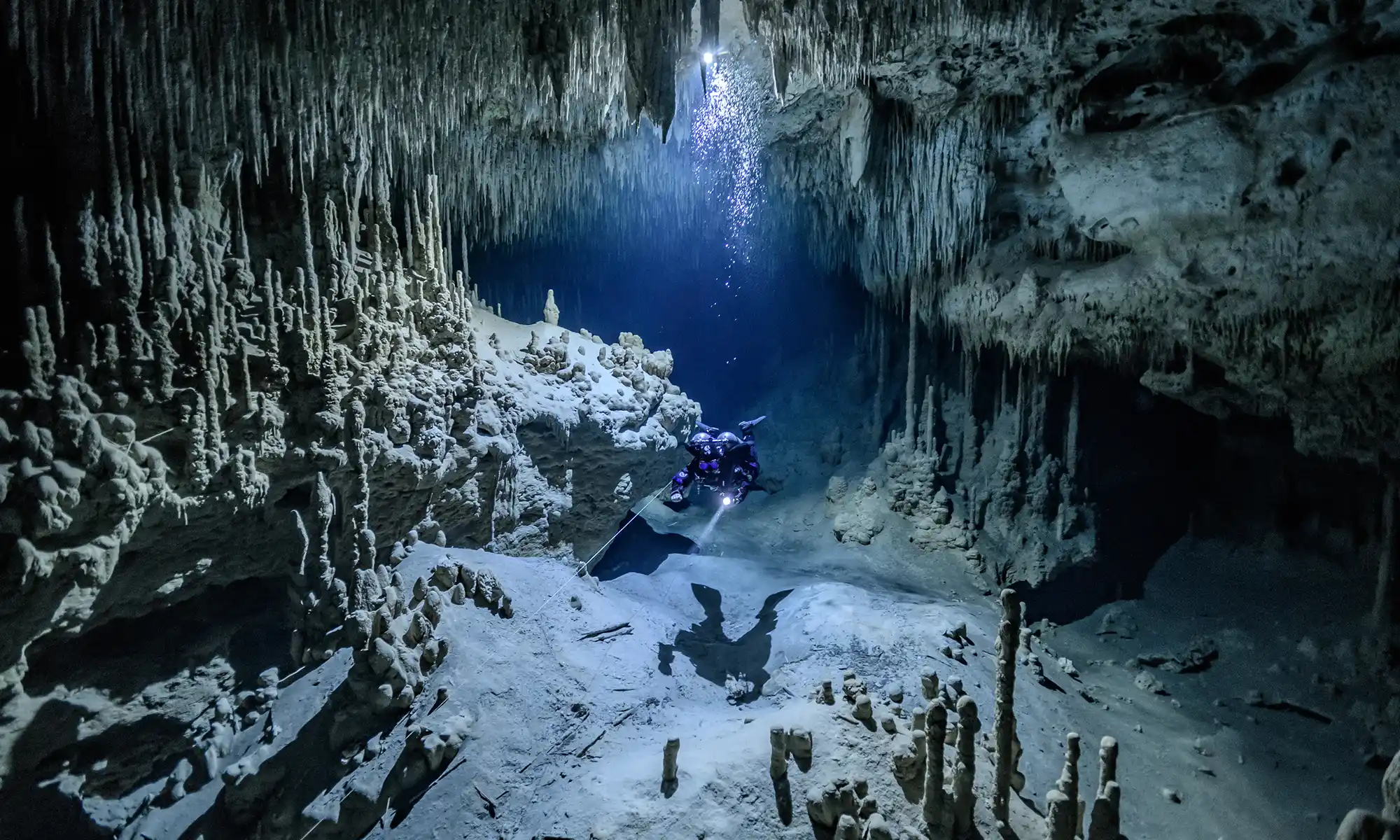While diving the Riviera Maya cenotes, you can witness the geological calendar. You will see spectacular formations formed during the last Ice Age and appreciate the archaeological discoveries through your mask. As visitors, cave and cavern divers learn to be safe and careful to observe and preserve this unique and beautiful cave environment.
The word “cenote” is derived from a Mayan term D’zonot and represents a subterranean cave that contains permanent water.
Types of underwater cenotes and caves
There are five categories of underwater caves:
- Sea caves
- Coral caves
- Lava flow caves
- Glacier caves
- Solution caves
They share similarities in composition, general location, shapes, and tools of origin. Solution caves represent most of the caves found worldwide and makeup all the cenotes and underground cave systems along the eastern Yucatan Peninsula.
Limestone is a large grouping of similar minerals comprising calcium carbonate (CaCO3). The shallow tropical oceans help produce an abundance of these sediments called lime. Most of the lime derives from the calcium skeletons of marine animals and some types of algae. These sediments accumulate over geological time and form into layers. Time, pressure, and temperature solidify these sediments into rock material. The compacting, cement bonding and recrystallization of the lime sediments accomplish this metamorphosis.
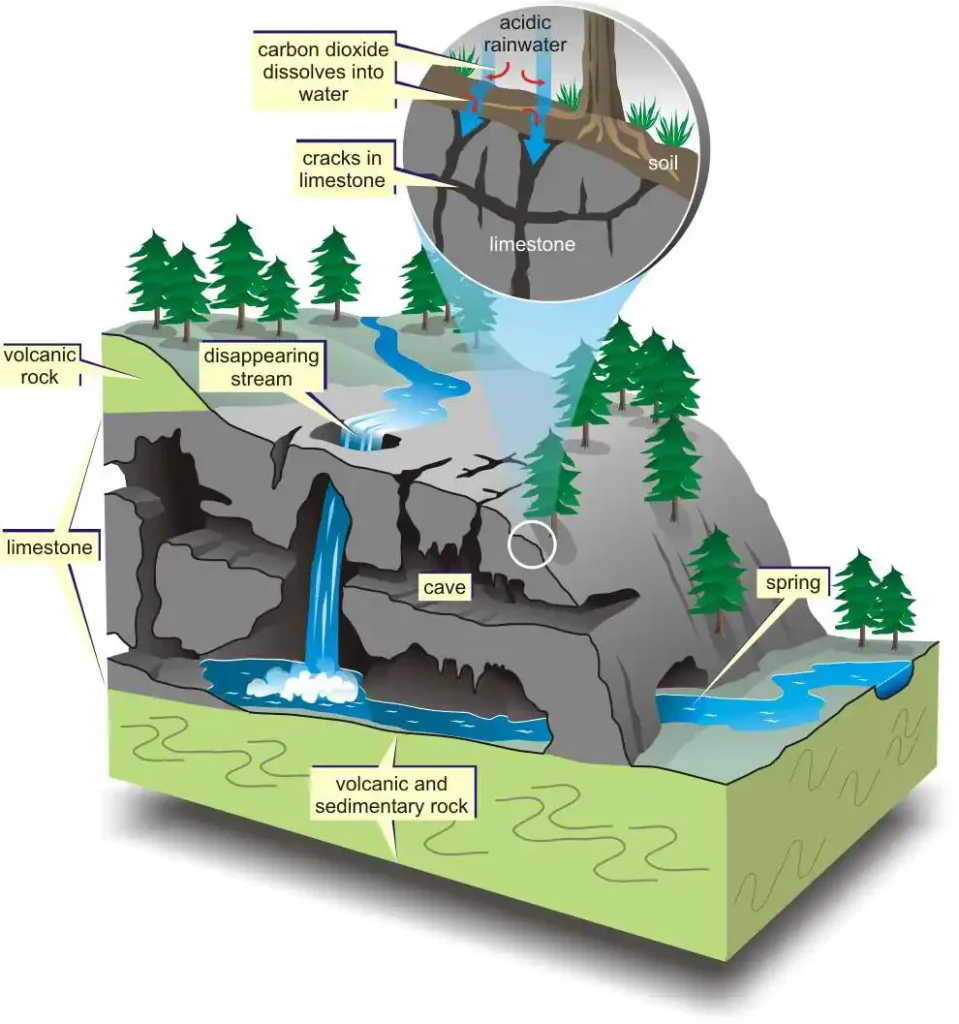
Dissolution is the breakdown and removal of rock formation caused by acids facilitated by freshwater circulation within the pores that comprise part of the rock’s volume.
Evolution of cenotes
The tremendous presence of limestone collapses characterizes the landscape as the ideal karst terrain. A steady underground water movement through a vast passage network flows where it finds the least resistance. The volume of water drainage is so great that it cannot exist on the surface. The soft, porous limestone highly filters all water, causing it to flow underground.
We know the evolution of cave passageways that form or exist below the water table as the phreatic zone. The water moves through the passageways (pores) vertically and horizontally from higher to lower pressure.
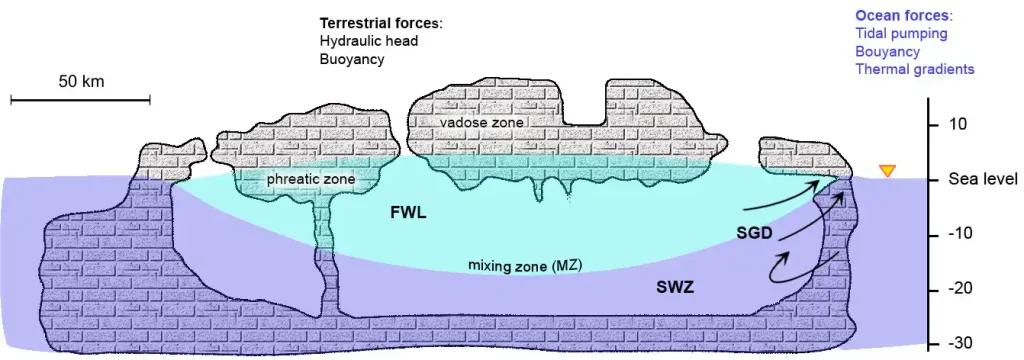
The vadose zone is any chamber, passage, or air space that forms above the aquifer. Many vadose passages and rooms exist in both the local cavern areas and cave systems. The Riviera Maya is a thick limestone with low relief and a high water table. The water table rose and fell during the last Ice Age, causing rapid cave development and creating the best surroundings for cave diving.
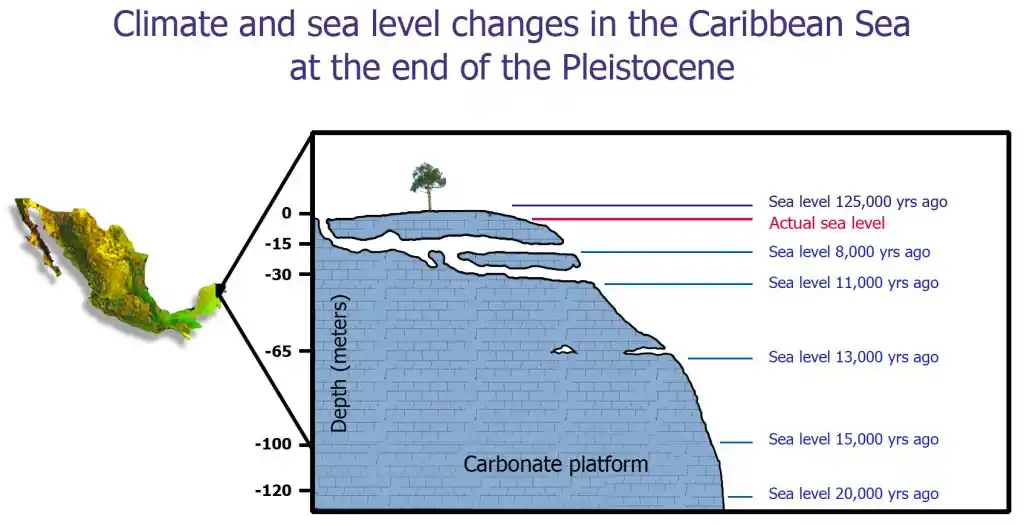

World ocean level simulation +10 meters / -130 meters
Physical features of the cenotes
Any time a cave diver plans to explore a new cenote, it is important to understand the physical features and water flow. Cave openings provide information about water movement, the point of the compass, clarity, and general characteristics. Understanding these clues allows the cave diver to explore the potential cave system with the best results.
Cenotes can be any shape or size. They can appear as a pond, such as the Cenote Carwash; a tiny shaft, such as Cenote Mundo Escondido (Hidden World); a crack, hole, or lagoon. Any form of collapse can represent a cenote. Cenotes can also be mostly dry, with the jungle continuing to survive inside the basin and water flowing around the edges. Good examples include the Grand Cenote, Cenote Chac Mool, and Cenote Tajma Ha. Cenotes can also be filled with water.
Water in the cenotes
Distances from the normal land surface to the water can vary from a few feet up to thirty feet (ten meters). Consider the difference in distance at Cenote Naharon (Cristal), which drops only one foot, compared to Cenote Dos Ojos, which falls over twenty-five feet (7.6 meters) from top to bottom. The surface and topography of the land and the underground water table play important roles in the cenote formation.
Water that flows into the cenote is called the spring side or upstream area, also known as the outlet. Water that flows from the cenote back underground is known as the siphon side or downstream area.
Hazards exist when diving downstream because of the minimal water flow. Water in the cenote basin is called the pool. The water volume and flow will vary, but the water flow is minimal because most water drainage originates from a horizontal source and not depth. Cenotes close to the coast, such as Cenote Manati (Casa cenote), may be affected by water flow or reverse direction due to the tides. Water levels will fluctuate by 12 in or more in the Cenote El Eden between a high and low tide. In cave passages, you can view saltwater moving upstream while the freshwater continues to drain downstream.
These cenotes are known as anchialine pools, a term coined by Holthuis (1973) to denote “pools with no surface connection to the sea, containing salt or brackish water, which fluctuates with the tides.”
How Solution Cenotes and Caves Form
Several conditions are necessary to form solution caves. These items are:
- host rock,
- groundwater,
- structural setting,
- and time.
The host rock is the limestone found in the Yucatan. Between this bond of limestone cement and these granules are spaces called porosity. Add the rock material’s ability to transmit fluids, making the limestone permeable.
A constant flow of freshwater dissolves away the calcium carbonate. Fresh water is more acidic because it has higher dissolved carbon dioxide (CO2) and humic acids. Acidity allows the aggressive dissolution of calcium carbonate to break down the cement that bonds the original particles together. The naturally occurring mixture of CO2 and water creates carbonic acid (H2CO3).
Groundwater must continually flow with fresh, chemically unsaturated water, passing through the rock pores to flush the newly dissolved cement away from the particles. Freshwater flow is an important process in the formation of solution caves.
The structural setting is an integral process in the formation of caves. Most caves form when the cave passages are immersed in the freshwater flow of the aquifer so that the calcium carbonate glue is exposed to maximum decomposition and dissolution.
Time is the overall factor that forms caves. Thousands of years’ worth of constant reactions and water movement are necessary for cave development. This geological calendar allows the cave to evolve, shape itself, and form the decorations and characteristics it contains.
Speleothems
Picture yourself floating through some of the most decorated caves in the world. You only need to drive 2.5 km south of Akumal to a commercial dry cave called Aktun Chen, the wood cave. This cave adventure is very popular because it will dazzle your imagination and answer the most commonly asked questions: Why cavern dive, and what do you people see in caves? Aktun Chen is an archaeological gallery of cave formations produced by mineral deposits known as speleothems. The name is taken from the Greek spelling meaning “cave” and thema meaning “deposit.” Speleothems are mineral deposits that formed when the environmental conditions were just right. This occurrence in the cenotes took place during the last Ice Age.
Most speleothems are made up of crystallized calcium carbonate. The deposits can evolve into any shape or form. The most common and familiar speleothems are stalactites and stalagmites. When it rains, groundwater seeps through the porous limestone and into the cave, where carbon dioxide can be absorbed into the cave atmosphere. This outgassing of carbon dioxide from the groundwater makes calcium carbonate and precipitates calcite.

The first step in forming these beautiful cave features begins with soda straws. They are hollow, tubular calcite stalactites usually no bigger in diameter than the water droplet that formed them. If the water droplets can flow down outside the soda straw, they become thicker and form a stalactite.
Various speleothems
The following descriptions explain the various names of speleothems:
- Draperies – calcium carbonate forming as layers or drapes from water droplets flowing down walls or ceilings.
- Helictites are calcium carbonate that forms twisting, irregularly shaped branches or twig-like rods that extrude from the walls or ceiling. Water oozes through the central core of the formation, defying gravity. They can evolve into very odd designs and form in random directions.
- Columns – form when stalactites and stalagmites join together.
- Flowstone – a thin film of calcium carbonate from water flowing down a wall.
- Dripstone – dripping water forming speleothems such as stalactites and stalagmites.
- Rimstone dam – a calcium carbonate deposit that forms around a cave pool or tends to obstruct a cave stream
The appearance of underwater speleothems that form only in the air indicates that the underwater caves of the Riviera Maya were once dry and are now immersed by rising water levels.
Our unique expandable interactive map of Riviera Maya cave diving cenotes is available for Cave Certified divers
| – Cenotes available for Open Water divers and Cave Certified divers | ||
| – Cenotes available for Cave Certified divers only |
🗺️ Additional Way to Find Updated Cave Maps on Our Website
The most up-to-date Mexican cave maps are available directly in the top menu of this website under the section “MEXICAN CENOTES & CAVES.”
There, you can explore interactive and downloadable maps organized by geographic area, for example: “PUERTO AVENTURAS CAVES AREA,” “CHEMUYIL CAVES AREA,” “DOS OJOS CAVE AREA,” and many more.
Use this menu to quickly find the detailed maps and information for the specific cave systems and cenotes you are interested in across the Riviera Maya.
Back
